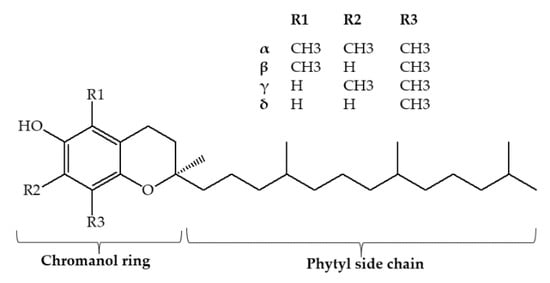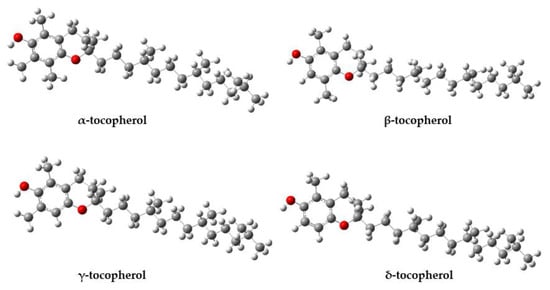Abstract
In the search for the tocopherols structure-reactivity relationship, our calculations showed that the GAP, which is the difference between the energy values of the frontier orbitals, decreases during the passage gas/aqueous medium for the isoforms α, β and γ. But it increases for isoform δ. This means that the latter is less reactive and less soft than the others in aqueous medium. On the other hand, the chemical descriptors calculations revealed that the transfer of electrons takes place in the direction α < β < γ < δ in the gas state and aqueous medium.
1. Introduction
Discovered in 1922 by Evans and Bishop [1], vitamin E is a product found in plants, vegetable oils and certain foods. These products can be tocopherols or tocotrienols. The antioxidant power of tocopherols results in the transfer of the hydroxyl’s protons from its systems to ROO• peroxized radicals and inhibits the radical propagation chain in a lipid environment [2]. Thus, it is the chromanol group that prevents the process of harmful peroxidations [3]. Reports indicate that there are conflicting results in clinical studies on the regulation of vitamin E (isoform α-) of allergic inflammation. They also strongly recommend considering dietary intake of tocopherols as isoform γ- is more abundant in Western diets [4]. On the other hand, the reverse phase HPLC technique does not distinguish between the two isomers β- and γ- but it has been widely used [5] as if the majority of vegetable oils were devoid of β-tocopherol [6]. This is why we are involved in the study of the structures and properties of tocopherols. There are four systems that differ in sites and number of methyl substituents on the chromanol ring. Named: α-, β-, γ- and δ-tocopherol isoforms. Knowing that the separation of these isoforms and their studies is of increasing interest to researchers [6,7,8,9,10,11] (Figure 1).

Figure 1.
Tocopherols structures.
2. Methods
Given the size of our systems, we calculated the structures using the PM3 [12] semi-empiric parametrization and B3Lyp/6-31G* method for the four tocopherols (α-, β-, γ- and δ-). Molecular orbitals of the optimized systems were obtained using the program implemented NBO [13] in Gaussian09 [14]. Semi-empirical calculations were performed with HyperChem [15].
Density functional theory (DFT) has been shown to be effective in providing theoretical information on chemical reactivity and selectivity in terms of qualitative chemical concepts such as electronegativity (χ), hardness (η), softness (S), electrophilic index (ω). The ionization potential is defined by the amount of energy required to remove an electron from a molecule. The latter is related to the energy of the highest occupied molecular orbital (HOMO) according to the equation: I = −EHOMO. On the other hand, electron affinity is defined as the energy released when a proton is added to a system. It is related to the energy of the lowest unoccupied molecular orbital (LUMO) by the equation: A = −ELUMO.
Based on the calculated values of the electronic potential and the electronic affinity, the values of electronegativity (χ), chemical potential (µ), chemical hardness (η), chemical smoothness (S) and electrophilic index (ω) were determined.
3. Results
3.1. Structures
The structures obtained from the B3Lyp/6-31G* calculations are shown in Figure 2. The imaginary frequencies are not present in the frequency calculation analysis of the optimized structures. Given the aromaticity of the chromanol ring, it is almost flat except for the part surrounded by atom C(2) and atom C(4). It is slightly flexible. The comparison of the main dihedral angles generated by the three atoms C(2), C(3) and C(4) showed that the results obtained with PM3 are reachable. The angles obtained at B3Lyp/6-31G* are identical to those obtained by Fabijanic and col. [16] using B3Lyp/6-311+++G**. This shows that such extensive basic choice is not necessary (Figure 3, Table 1).

Figure 2.
Calculated structures using the DFT method.

Figure 3.
The tocopherols atom numbering.

Table 1.
The tocopherols dihedral angles of the optimized structures expressed in°.
The calculated energies of the optimized structures with the PM3 method show that the isoform γ- is less stable than the isoform β- of 19.945 Kcal/mol. This is probably due to steric discomfort generated by the adjacent positions of methyls on the chromanol ring of isoform γ-. Unlike energy calculations, thermodynamic calculations favor isoform γ- over isoform β-. The free energy difference is estimated at 376.0 Kcal/mol.
3.2. Dipolar Moment
Isoform α- has the lowest dipolar moment value and the highest polarizability. For the others, the dipolar moment values remain close. They vary in the same direction as those obtained in PM3. The difference between the values of isoform α- and those of the others is probably due to the presence of hydrogen on the aromatic ring of β-, δ- and γ- one and their absence on that of the first (see Table 2 and Figure 1).

Table 2.
Calculated values of the dipolar moment expressed in Debye.
3.3. Reactivity
The value of the GAP decreases slightly (about 0.0020 eV) during the transition from gas to aqueous medium for the isoforms α-, β- and γ-. On the other hand, it increases for isoform δ-. A molecule with a small gap is generally associated with high chemical reactivity and low kinetic stability. From this point of view, the first three systems are more reactive in aqueous solution, which makes them softer than the last tocopherol (Table 3).

Table 3.
GAP values expressed in eV.
Our results show that the variation of the electronic chemical potential of tocopherols in both media is in this direction: α > β > γ > δ, and the electron transfer is in the opposite direction. The electronegativity values confirm these results. The δ-tocopherol is the most electronegative because of the presence of two hydrogen atoms on the aromatic ring instead of the methyl radicals of the α-tocopherol. A difference in electronegativity is clearly visible for the isoforms β- and γ-. The position of the Hydrogen atom has a significant influence on the electronegativity value.
Chemical hardness is associated with the stability and reactivity of a chemical system. It measures resistance to change in electron distribution or charge transfer. The values of η show that the isoforms α and γ remain almost identical in hardness. On the other hand, β-tocopherol is harder, and δ-tocopherol is softer. The hardness of tocopherols decreases in aqueous medium. They evolved from a balanced form to an unstable form with the exception of isoform δ. As expected, the presence of water increases the electrophilicity of the four tocopherols (Table 4).

Table 4.
The main calculated chemical descriptors of the four tocopherols obtained in B3Lyp/6-31G* (expressed as eV).
4. Conclusions
The difference in electronegativity for isoforms β and γ is clearly visible. Our results show that the electron transfer takes place in the direction α < β < γ < δ in both media (gas and aqueous solution).
Our results can contribute to understanding the behavior of tocopherols in reaction media.
Author Contributions
Conceptualization, N.B. and Z.B.; Methodology, N.B., K.Z.-B. and Z.Z.; Validation, N.B., K.Z.-B. and Z.B.; Formal Analysis, N.B. and K.Z.-B.; Investigation, N.B., K.Z.-B. and Z.B.; Writing—Original Draft Preparation, N.B. and Z.B.; Writing—Review and Editing, N.B., Z.Z. and Z.B. All authors have read and agreed to the published version of the manuscript.
Funding
This research received no external funding.
Institutional Review Board Statement
Not applicable.
Informed Consent Statement
Not applicable.
Data Availability Statement
Data available on request.
Conflicts of Interest
The authors declare no conflict of interest.
References
- Evans, H.M.; Bishop, K.S. On the Existence of a Hitherto Unrecognized Dietary Factor Essential for Reproduction. Science 1922, 56, 650–651. [Google Scholar] [CrossRef] [PubMed]
- Peh, H.Y.; Tan, W.S.D.; Liao, W.; Wong, W.S.F. Vitamin E Therapy beyond Cancer: Tocopherol versus Tocotrienol. Pharmacol. Ther. 2016, 162, 152–169. [Google Scholar] [CrossRef] [PubMed]
- Jiang, Q. Natural Forms of Vitamin E: Metabolism, Antioxidant, and Anti-Inflammatory Activities and Their Role in Disease Prevention and Therapy. Free. Radic. Biol. Med. 2014, 72, 76–90. [Google Scholar] [CrossRef] [PubMed]
- Smit, H.A.; Grievink, L.; Tabak, C. Dietary Influences on Chronic Obstructive Lung Disease and Asthma: A Review of the Epidemiological Evidence. Proc. Nutr. Soc. 1999, 58, 309–319. [Google Scholar] [CrossRef] [PubMed]
- Tan, B.; Brzuskiewicz, L. Separation of Tocopherol and Tocotrienol Isomers Using Normal- and Reverse-Phase Liquid Chromatography. Anal. Biochem. 1989, 180, 368–373. [Google Scholar] [CrossRef] [PubMed]
- Cuvelier, C.; Dotreppe, O.; Istasse, L. Chemistry, Nutritional Sources and Analyses of Vitamin E. Ann. De Med. Vet. 2003, 147, 315–324. [Google Scholar]
- Abidi, S.L. Chromatographic Analysis of Tocol-Derived Lipid Antioxidants. J. Chromatogr. A 2000, 881, 197–216. [Google Scholar] [CrossRef] [PubMed]
- Fu, J.-Y.; Htar, T.-T.; De Silva, L.; Tan, D.M.; Chuah, L.-H. Chromatographic Separation of Vitamin E Enantiomers. Molecules 2017, 22, 233. [Google Scholar] [CrossRef] [PubMed]
- Yang, J.; Rainville, P. Chiral Separation of α-Tocopherol and α-Tocopheryl Acetate by Supercritical Fluid Chromatography for Accurate Vitamin E Nutrition Labeling. J. Food Compos. Anal. 2023, 117, 105135. [Google Scholar] [CrossRef]
- Yu, G.; Pawar, M. PEI-Loaded SiO2 as an Adsorbent for Separation of α-Tocopherol from Tocopherol Homologues. Monatshefte Für Chem. Chem. Mon. 2023, 154, 65–70. [Google Scholar] [CrossRef]
- Tsimidou, M.Z.; Mantzouridou, F.T.; Nenadis, N. Chapter Two—Minor Bioactive Lipids. In Advances in Food and Nutrition Research; Gallegos, C., Ruiz-Méndez, M.-V., Eds.; Academic Press: Cambridge, MA, USA, 2023; Volume 105, pp. 51–95. ISBN 1043-4526. [Google Scholar]
- Stewart, J.J.P. Optimization of Parameters for Semiempirical Methods II. Applications. J. Comput. Chem. 1989, 10, 221–264. [Google Scholar] [CrossRef]
- Glendening, E.D.; Reed, A.E.; Carpenter, J.E.; Weinhold, F. NBO, Version 3.1; Gaussian Inc.: Pittsburgh, PA, USA, 2003. [Google Scholar]
- Frisch, M.J.; Trucks, G.W.; Schlegel, H.B.; Scuseria, G.E.; Robb, M.A.; Cheeseman, J.R.; Scalmani, G.; Barone, V.; Petersson, G.A.; Nakatsuji, H.; et al. Gaussian 09; Gaussian, Inc.: Wallingford, CT, USA, 2009. [Google Scholar]
- Hypercube Inc. Scientific Software Company, Incorporated in 1985. Available online: https://www.chemits.com/en/software/molecular-modeling/hyperchem/ (accessed on 14 October 2023).
- Fabijanić, I.; Jakobušić Brala, C.; Pilepić, V. The DFT Local Reactivity Descriptors of α-Tocopherol. J. Mol. Model. 2015, 21, 99. [Google Scholar] [CrossRef] [PubMed]
Disclaimer/Publisher’s Note: The statements, opinions and data contained in all publications are solely those of the individual author(s) and contributor(s) and not of MDPI and/or the editor(s). MDPI and/or the editor(s) disclaim responsibility for any injury to people or property resulting from any ideas, methods, instructions or products referred to in the content. |
© 2023 by the authors. Licensee MDPI, Basel, Switzerland. This article is an open access article distributed under the terms and conditions of the Creative Commons Attribution (CC BY) license (https://creativecommons.org/licenses/by/4.0/).